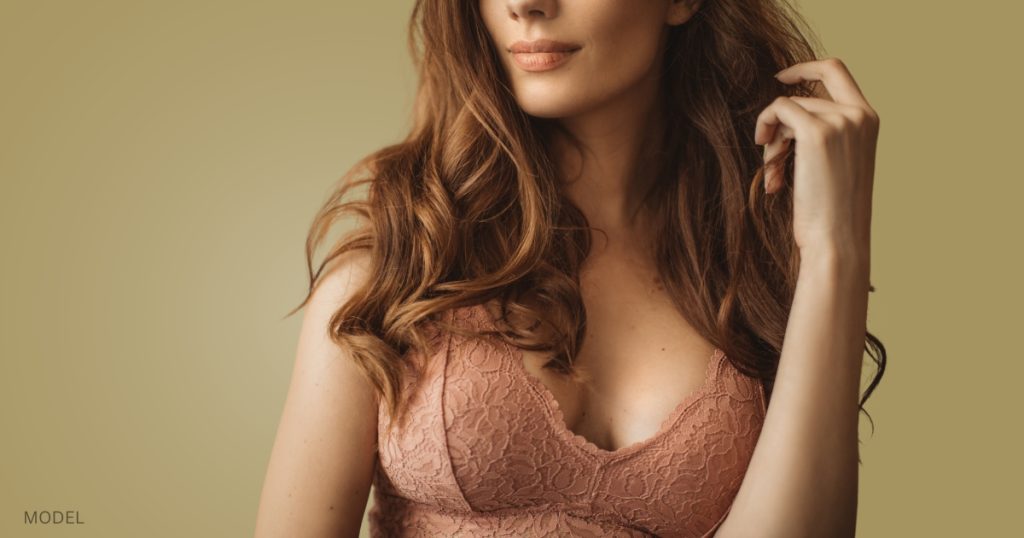Thinking about breast augmentation but unsure which option is right for you? Today’s most popular choices—breast implants and natural breast augmentation with fat transfer—offer very different benefits. By weighing the pros and cons of fat transfer vs. implants, you can better understand which approach aligns with your goals for size, shape, and recovery.
Natural ‘Boob Job’ With Fat Transfer: The Pros
1. Natural look and feel: Fat transfer breast augmentation uses your body’s own fat, which is softer and more pliable than silicone or saline implants. Your breasts will look and feel natural, only with subtle enhancements in size and shape.
2. Dual benefits: To augment your breasts, the fat transfer method involves liposuction to harvest fat from other areas of your body, such as the abdomen, flanks, or thighs. This means you get the added benefit of body contouring in a “problem area” while enhancing your breasts.
3. Minimal scarring: Only small incisions are required to insert the harvested fat, which generally results in little to no visible scarring compared to implant-based surgery.
Fat Transfer: The Cons
1. Limited volume increase: Fat transfer creates a modest enhancement (typically around one cup size). This technique may not be the best choice if your goal is a more dramatic change.
2. Less predictable outcome: Not all of the transferred fat cells ‘take’ to their new location. This can make results less predictable, and some patients may need touch-up procedures for symmetry or volume refinement.
3. Dependent on donor fat availability: Fat transfer needs sufficient excess fat from a donor area for safe outcomes and flattering results. This procedure may not be an option for those with a particularly lean body type.
Breast Augmentation With Implants: The Pros
1. More dramatic results: Breast implants allow for significant increases in volume, projection, and shape that fat transfer alone cannot achieve.
2. Immediate and predictable outcomes: Implants provide a noticeable, reliable change in size and shape right away. With today’s advanced options—such as cohesive gel (“gummy bear”) implants—results are both natural-looking and long-lasting.
3. Highly customizable: Implants come in a wide variety of sizes, shapes, and profiles, making it easier to tailor your results to your exact aesthetic goals.
Breast Implants: The Cons
1. Risk of Complications: Like any surgery, implant procedures carry risks. Specific risks include capsular contracture, implant rupture, or implant displacement, although these remain relatively uncommon.
2. More Visible Scarring: Implants require larger incisions (often hidden under the breast fold or around the areola). Scars are well-placed but generally more visible than the tiny entry points used in fat transfer.
3. Future Maintenance: Implants are not considered lifetime devices. While many last 10–15 years without issues, you should be prepared for the possibility of replacement or revision surgery in the future.
Fat Transfer vs. Implants
| Factor | Fat Transfer (Natural Breast Augmentation) | Breast Implants |
| Volume Increase | Subtle (usually < 1 cup size) | Moderate to dramatic |
| Look & Feel | Very natural, soft | Can be very natural with modern implants |
| Scarring | Minimal (tiny incisions) | Larger, but hidden (in fold/areola) |
| Dual Benefits | Body contouring + breast enhancement | Breast enhancement only |
| Predictability | Less predictable (fat survival varies) | Highly predictable |
| Recovery | Shorter, generally mild discomfort | Slightly longer recovery, more initial discomfort |
| Longevity | Permanent fat survival, but touch-ups may be needed | Long-lasting, but may require future replacement |
| Candidate Requirements | Must have sufficient donor fat | Suitable for a wide range of body types |
Which Approach Is Right for You?
With or without implants, breast augmentation can give you your desired shape and look. The right choice for you depends on your goals for enhancement:
-
Choose fat transfer if you want a subtle, natural enhancement and have enough donor fat available.
-
Choose implants if you want more dramatic, customizable, and predictable results.
In some cases, patients even benefit from a combination of both techniques, using implants for volume and fat transfer for refinement.
Request a Consultation
The best way to decide between fat transfer and implants is to meet with a trusted board-certified plastic surgeon. During your consultation, we’ll assess your body, discuss your goals, and design a personalized treatment plan to help you achieve your ideal results. If you’d like to learn more about your options, please call our office at (650) 325-1118 (Palo Alto) or (408) 371-1118 (Campbell). Or, request a consultation online to get started.
This blog post was originally published in April 2023 and has been updated for 2025.









Leave a Reply